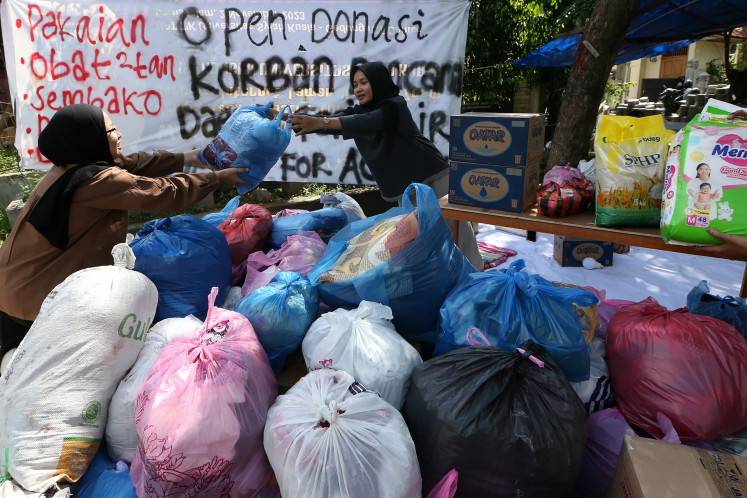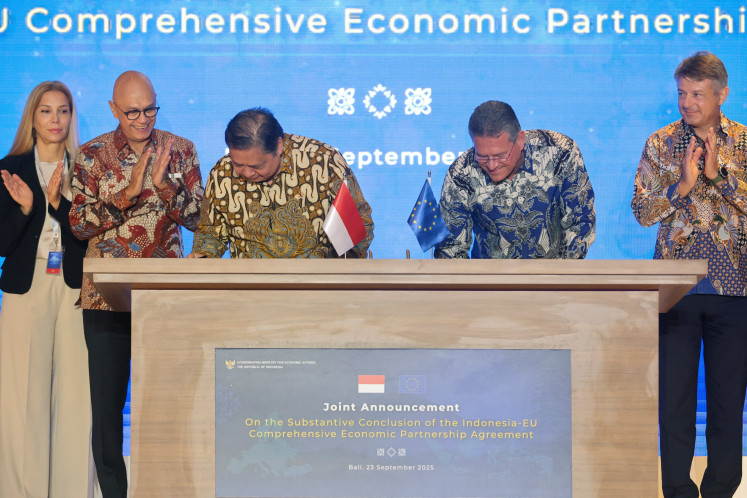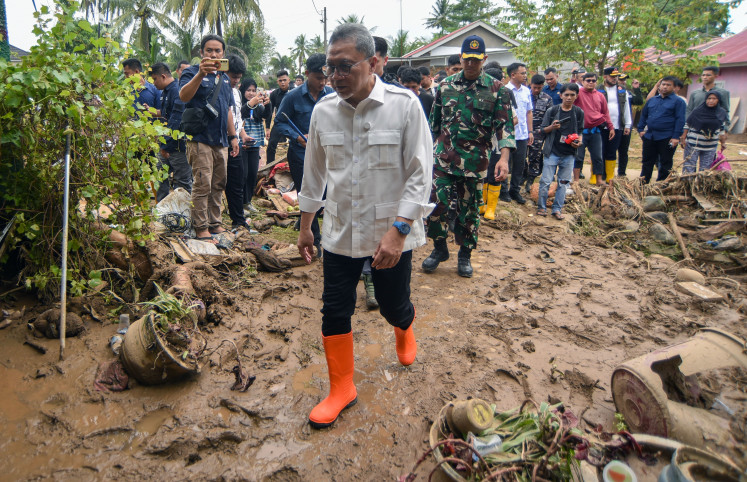Popular Reads
Top Results
Can't find what you're looking for?
View all search resultsPopular Reads
Top Results
Can't find what you're looking for?
View all search resultsMinangkayo, digging up Minangkabau's cultural riches
Iconic dish: A serving of ketupat sayur (rice compressed in woven palm leaf pouches and vegetable curry) with pakis (fern) is a signature dish from Padang, West Sumatra, often served with rendang (beef simmered in coconut milk and spices), another signature dish from Padang that is associated with the Minangkabau people
Change text size
Gift Premium Articles
to Anyone
There is more to Minangkabau culture than rendang and nasi Padang, as a trio is trying to convey through website Minangkayo.
The most immediate association of Minangkabau, a region and ethnic group in West Sumatra, is its appetizing Padang cooking, an icon of the groupâs diaspora across the archipelago, especially its younger members.
âIn my view, many other features of Minang culture should be brought into the limelight, apart from its food and dances. Even the cuisine isnât just whatâs popular at Padang restaurants; thereâs a lot more to it,â said Reno Andam Suri, who with her friends Febiliana Sari and Ichil Salam is behind website minangkayo.com. Minang kayo literally means rich Minang.
The three, who met in a society of gourmands, Jalansutra, have a common interest in Minang cooking and culture.
âFebi and I belong to the Minang ethnic group and have our own online businesses selling rendang,â revealed Reno. Rendang, the cuisineâs most noted dish, is beef simmered in coconut milk and spices.
With Ichil, a native of Klaten in Central Java, they set up the website, which serves as an e-magazine to promote a community of online Minang culture lovers.
Reno and Ichil have to constantly remind themselves and others that Minangkayo isnât just a forum to discuss food, despite their passion for cooking.
When they started the website in mid-2015, they agreed to conduct research on non-culinary subjects as well for further dissemination in easily digestible language.
The trio therefore seeks information from original sources to produce stories of historical and cultural significance. Regarding recipes, for instance, they hunt old formulas used by previous generations down to remote areas to trace their history and discover their ingredients for testing and dissemination.
 Iconic dish: <)
Iconic dish: <)
I
span class="caption">Iconic dish: A serving of ketupat sayur (rice compressed in woven palm leaf pouches and vegetable curry) with pakis (fern) is a signature dish from Padang, West Sumatra, often served with rendang (beef simmered in coconut milk and spices), another signature dish from Padang that is associated with the Minangkabau people.(Courtesy of Minangkayo)
There is more to Minangkabau culture than rendang and nasi Padang, as a trio is trying to convey through website Minangkayo.
The most immediate association of Minangkabau, a region and ethnic group in West Sumatra, is its appetizing Padang cooking, an icon of the group's diaspora across the archipelago, especially its younger members.
'In my view, many other features of Minang culture should be brought into the limelight, apart from its food and dances. Even the cuisine isn't just what's popular at Padang restaurants; there's a lot more to it,' said Reno Andam Suri, who with her friends Febiliana Sari and Ichil Salam is behind website minangkayo.com. Minang kayo literally means rich Minang.
The three, who met in a society of gourmands, Jalansutra, have a common interest in Minang cooking and culture.
'Febi and I belong to the Minang ethnic group and have our own online businesses selling rendang,' revealed Reno. Rendang, the cuisine's most noted dish, is beef simmered in coconut milk and spices.
With Ichil, a native of Klaten in Central Java, they set up the website, which serves as an e-magazine to promote a community of online Minang culture lovers.
Reno and Ichil have to constantly remind themselves and others that Minangkayo isn't just a forum to discuss food, despite their passion for cooking.
When they started the website in mid-2015, they agreed to conduct research on non-culinary subjects as well for further dissemination in easily digestible language.
The trio therefore seeks information from original sources to produce stories of historical and cultural significance. Regarding recipes, for instance, they hunt old formulas used by previous generations down to remote areas to trace their history and discover their ingredients for testing and dissemination.
Sweet tooth: An assortment of sweet traditional snacks from the Minangkabau region. The bottle in the center of the dish contains palm sugar syrup.(Courtesy of Minangkayo)
Minagkayo's aim, then, is introduce Minang and non-Minang youths everywhere to the diverse aspects of Minang culture without copying the existing material. 'We wish to write genuine information from authentic sources while also providing our readers with a broader scope of knowledge,' explained Reno.
Writing detailed accounts is nothing new to the three partners. Reno has authored a book, Rendang Traveler, which earned her a Gourmand Award at the Cookbook Festival in Beijing in 2014. Ichil and Feb are also accustomed to culinary research work while touring different islands in the country for their comprehensive articles.
Visitors to Minangkayo can now access stories of the first Padang restaurant in Jakarta and a history of Minang coffee. Minang people were once known as coffee leaf brewers, while the area of Solok was a major coffee producing region in the Dutch colonial era. 'Local farmers' self-esteem and defiance of the Dutch made them burn their plants and refuse to grow coffee again,' said Ichil, who is now eager to reintroduce Solok coffee to the public.
The first event held by Minangkayo was a Jamuan Bajamba party as part of the Spice Trail, an exhibition of spice regions all over Indonesia and their impact on the world economy. A bajamba is a Minang communal feast given by families, serving special dishes with rice laid on a large tray surrounded by dishes and vegetables to maintain intimate ties between families and guests.
The other event was a Minang-style coffee drinking gathering with various snacks of the region. The program, attended by a fair number of coffee lovers, was also designed as a chatting session. Solok coffee was served in different ways, such as manual-brew and cold-brew methods and also in modern forms like cappuccino and piccolo.
After the coffee morning, a bopet (dining) event offered ketupat sayur (rice cakes and vegetable curry) with pakis (fern) derived from Padang and shredded rendang. Bopet is actually a typical Minang café with limited local dishes prepared on plates like ketupat sayur, fried rice and porridge.
As explained on the website, bopet comes from the French word buffet, meaning dishes for self-service. The Dutch adopted the word to mean a sideboard. When it reached West Sumatra, it turned into bopet or cupboard, known better known as an eatery, and a constant feature of Minangkayo programs.
Completely delicious: Ketupat sayur is a complete meal consisting of ketupat (rice compressed in woven palm leaf pouches), rendang and vegetable curry.
Reno mentioned Minangkayo's plans to organize events in unique packages.
'Febi wants to arrange a tour of coffee plantations during bumper harvests, or an open-park dinner with Minang dance entertainment,' she added.
Through such activities to draw the public closer to Minang culture, the young Minangkayo movement seems to have great things in store for the future.
' Photos by Juliana Harsianti











